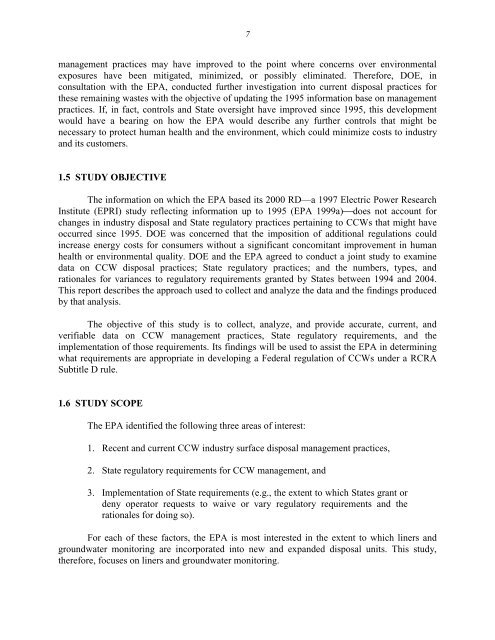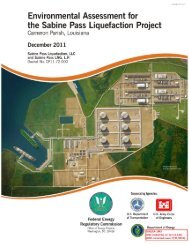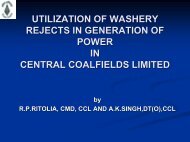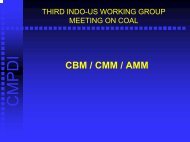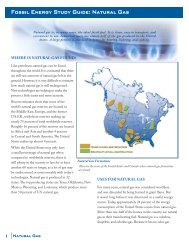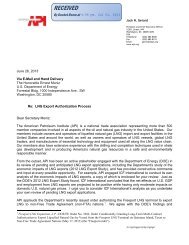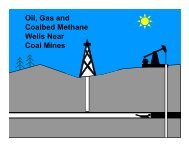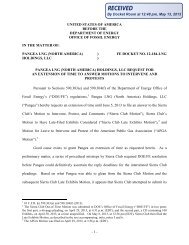Coal Combustion Waste Management at - DOE - Fossil Energy ...
Coal Combustion Waste Management at - DOE - Fossil Energy ...
Coal Combustion Waste Management at - DOE - Fossil Energy ...
You also want an ePaper? Increase the reach of your titles
YUMPU automatically turns print PDFs into web optimized ePapers that Google loves.
7<br />
management practices may have improved to the point where concerns over environmental<br />
exposures have been mitig<strong>at</strong>ed, minimized, or possibly elimin<strong>at</strong>ed. Therefore, <strong>DOE</strong>, in<br />
consult<strong>at</strong>ion with the EPA, conducted further investig<strong>at</strong>ion into current disposal practices for<br />
these remaining wastes with the objective of upd<strong>at</strong>ing the 1995 inform<strong>at</strong>ion base on management<br />
practices. If, in fact, controls and St<strong>at</strong>e oversight have improved since 1995, this development<br />
would have a bearing on how the EPA would describe any further controls th<strong>at</strong> might be<br />
necessary to protect human health and the environment, which could minimize costs to industry<br />
and its customers.<br />
1.5 STUDY OBJECTIVE<br />
The inform<strong>at</strong>ion on which the EPA based its 2000 RD—a 1997 Electric Power Research<br />
Institute (EPRI) study reflecting inform<strong>at</strong>ion up to 1995 (EPA 1999a)⎯does not account for<br />
changes in industry disposal and St<strong>at</strong>e regul<strong>at</strong>ory practices pertaining to CCWs th<strong>at</strong> might have<br />
occurred since 1995. <strong>DOE</strong> was concerned th<strong>at</strong> the imposition of additional regul<strong>at</strong>ions could<br />
increase energy costs for consumers without a significant concomitant improvement in human<br />
health or environmental quality. <strong>DOE</strong> and the EPA agreed to conduct a joint study to examine<br />
d<strong>at</strong>a on CCW disposal practices; St<strong>at</strong>e regul<strong>at</strong>ory practices; and the numbers, types, and<br />
r<strong>at</strong>ionales for variances to regul<strong>at</strong>ory requirements granted by St<strong>at</strong>es between 1994 and 2004.<br />
This report describes the approach used to collect and analyze the d<strong>at</strong>a and the findings produced<br />
by th<strong>at</strong> analysis.<br />
The objective of this study is to collect, analyze, and provide accur<strong>at</strong>e, current, and<br />
verifiable d<strong>at</strong>a on CCW management practices, St<strong>at</strong>e regul<strong>at</strong>ory requirements, and the<br />
implement<strong>at</strong>ion of those requirements. Its findings will be used to assist the EPA in determining<br />
wh<strong>at</strong> requirements are appropri<strong>at</strong>e in developing a Federal regul<strong>at</strong>ion of CCWs under a RCRA<br />
Subtitle D rule.<br />
1.6 STUDY SCOPE<br />
The EPA identified the following three areas of interest:<br />
1. Recent and current CCW industry surface disposal management practices,<br />
2. St<strong>at</strong>e regul<strong>at</strong>ory requirements for CCW management, and<br />
3. Implement<strong>at</strong>ion of St<strong>at</strong>e requirements (e.g., the extent to which St<strong>at</strong>es grant or<br />
deny oper<strong>at</strong>or requests to waive or vary regul<strong>at</strong>ory requirements and the<br />
r<strong>at</strong>ionales for doing so).<br />
For each of these factors, the EPA is most interested in the extent to which liners and<br />
groundw<strong>at</strong>er monitoring are incorpor<strong>at</strong>ed into new and expanded disposal units. This study,<br />
therefore, focuses on liners and groundw<strong>at</strong>er monitoring.


